Air Online Test 8th Science Lesson 11 Questions in English
Air Online Test 8th Science Lesson 11 Questions in English
Air Online Test 8th Science Lesson 11 Questions in English
Quiz-summary
0 of 56 questions completed
Questions:
- 1
- 2
- 3
- 4
- 5
- 6
- 7
- 8
- 9
- 10
- 11
- 12
- 13
- 14
- 15
- 16
- 17
- 18
- 19
- 20
- 21
- 22
- 23
- 24
- 25
- 26
- 27
- 28
- 29
- 30
- 31
- 32
- 33
- 34
- 35
- 36
- 37
- 38
- 39
- 40
- 41
- 42
- 43
- 44
- 45
- 46
- 47
- 48
- 49
- 50
- 51
- 52
- 53
- 54
- 55
- 56
Information
Air Online Test 8th Science Lesson 11 Questions in English
You have already completed the quiz before. Hence you can not start it again.
Quiz is loading...
You must sign in or sign up to start the quiz.
You have to finish following quiz, to start this quiz:
Results
0 of 56 questions answered correctly
Your time:
Time has elapsed
You have reached 0 of 0 points, (0)
| Average score |
|
| Your score |
|
Categories
- Not categorized 0%
| Pos. | Name | Entered on | Points | Result |
|---|---|---|---|---|
| Table is loading | ||||
| No data available | ||||
- 1
- 2
- 3
- 4
- 5
- 6
- 7
- 8
- 9
- 10
- 11
- 12
- 13
- 14
- 15
- 16
- 17
- 18
- 19
- 20
- 21
- 22
- 23
- 24
- 25
- 26
- 27
- 28
- 29
- 30
- 31
- 32
- 33
- 34
- 35
- 36
- 37
- 38
- 39
- 40
- 41
- 42
- 43
- 44
- 45
- 46
- 47
- 48
- 49
- 50
- 51
- 52
- 53
- 54
- 55
- 56
- Answered
- Review
-
Question 1 of 56
1. Question
1. Which is a mixture of gases that surrounds our planet earth?
Correct
Explanation
Air is a mixture of gases that surrounds our planet earth. It is essential for the survival of all the living things.
Incorrect
Explanation
Air is a mixture of gases that surrounds our planet earth. It is essential for the survival of all the living things.
-
Question 2 of 56
2. Question
2. Air contain how many percentages of nitrogen?
Correct
Explanation
Air contains 78.09% of nitrogen.
Incorrect
Explanation
Air contains 78.09% of nitrogen.
-
Question 3 of 56
3. Question
3. Air contain how many percentages of oxygen?
Correct
Explanation
Air contains 78.09% nitrogen, 20.95% oxygen, 0.93% argon, 0.04% carbon dioxide and small number of other gases. We breath in oxygen and breath out carbon dioxide.
Incorrect
Explanation
Air contains 78.09% nitrogen, 20.95% oxygen, 0.93% argon, 0.04% carbon dioxide and small number of other gases. We breath in oxygen and breath out carbon dioxide.
-
Question 4 of 56
4. Question
4. Plants use which among the following gases for photosynthesis?
Correct
Explanation
Plants in turn use carbon dioxide for photosynthesis and release oxygen into the atmosphere. Since men have been cutting down trees for their needs, the amount of carbon dioxide in the atmosphere is increasing. This is responsible for the raising of atmospheric temperature
Incorrect
Explanation
Plants in turn use carbon dioxide for photosynthesis and release oxygen into the atmosphere. Since men have been cutting down trees for their needs, the amount of carbon dioxide in the atmosphere is increasing. This is responsible for the raising of atmospheric temperature
-
Question 5 of 56
5. Question
5. Which among the following are the gases released by industries and vehicles into atmosphere that has resulted in effects like global warming and acid rain?
Correct
Explanation
Industries and vehicles release gases like carbon monoxide and sulphur dioxide into the atmosphere. This has resulted in effects like global warming and acid rain which affect us in many ways. In total, the quality of air is gone in the modern days.
Incorrect
Explanation
Industries and vehicles release gases like carbon monoxide and sulphur dioxide into the atmosphere. This has resulted in effects like global warming and acid rain which affect us in many ways. In total, the quality of air is gone in the modern days.
-
Question 6 of 56
6. Question
6. Who Swedish scientist first discovered oxygen in 1772 and called oxygen as gas fire air?
Correct
Explanation
All living things in the world need oxygen. We cannot imagine the world without oxygen. Swedish chemist C.W. Scheele first discovered oxygen in 1772. He called the gas fire air or vital life because it was found to support the process of burning.
Incorrect
Explanation
All living things in the world need oxygen. We cannot imagine the world without oxygen. Swedish chemist C.W. Scheele first discovered oxygen in 1772. He called the gas fire air or vital life because it was found to support the process of burning.
-
Question 7 of 56
7. Question
7. Oxygen was independently discovered by which British scientist in 1774?
Correct
Explanation
Oxygen was independently discovered by the British scientist Joseph Priestley in 1774.
Incorrect
Explanation
Oxygen was independently discovered by the British scientist Joseph Priestley in 1774.
-
Question 8 of 56
8. Question
8. Who among the following named oxygen?
Correct
Explanation
Lavoisier named oxygen. The name oxygen comes from the Greek word ‘oxygenes’ which means ‘acid producer’. It is called so because early chemists thought that oxygen is necessary for all acids.
Incorrect
Explanation
Lavoisier named oxygen. The name oxygen comes from the Greek word ‘oxygenes’ which means ‘acid producer’. It is called so because early chemists thought that oxygen is necessary for all acids.
-
Question 9 of 56
9. Question
9. Which among the following element is more abundant than oxygen in the universe?
Correct
Explanation
Oxygen is the third most abundant element after Hydrogen and Helium in the universe. It occurs both in free state and combined state.
Incorrect
Explanation
Oxygen is the third most abundant element after Hydrogen and Helium in the universe. It occurs both in free state and combined state.
-
Question 10 of 56
10. Question
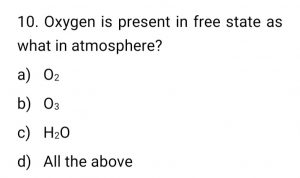 Correct
Correct
Explanation
Oxygen is present in free state as dioxygen molecule (O2) in the atmosphere. Most of this has been produced by the process photosynthesis in which the chlorophyll present in the leaves of plants uses solar energy to produce glucose.
Incorrect
Explanation
Oxygen is present in free state as dioxygen molecule (O2) in the atmosphere. Most of this has been produced by the process photosynthesis in which the chlorophyll present in the leaves of plants uses solar energy to produce glucose.
-
Question 11 of 56
11. Question
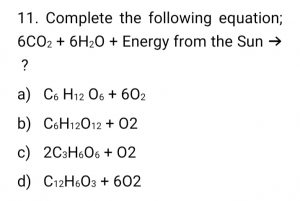 Correct
Correct
 Incorrect
Incorrect

-
Question 12 of 56
12. Question
12. In combined state oxygen is present in the earth’s crust as ______
Correct
Explanation
In combined state it is present in the earth’s crust as silicates and metal oxides. It is also found in the water on the surface of the earth.
Incorrect
Explanation
In combined state it is present in the earth’s crust as silicates and metal oxides. It is also found in the water on the surface of the earth.
-
Question 13 of 56
13. Question
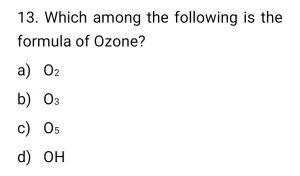 Correct
Correct
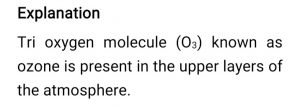 Incorrect
Incorrect

-
Question 14 of 56
14. Question
14. What is the percentage of Oxygen in free state in atmospheric air?
Correct
Explanation
Oxygen in free state in Atmospheric air is 21 % and in water is 88 – 90 %.
Incorrect
Explanation
Oxygen in free state in Atmospheric air is 21 % and in water is 88 – 90 %.
-
Question 15 of 56
15. Question
15. Which among the following is not the Physical property of Oxygen?
Correct
Explanation
Oxygen is a poor conductor of heat and electricity.
Incorrect
Explanation
Oxygen is a poor conductor of heat and electricity.
-
Question 16 of 56
16. Question
16. Oxygen can be made into liquid (liquified) at _____
Correct
Explanation
Oxygen can be made into liquid (liquified) at high pressure and low temperature.
Incorrect
Explanation
Oxygen can be made into liquid (liquified) at high pressure and low temperature.
-
Question 17 of 56
17. Question
17. Which among the following statement is correct
a) Oxygen is a non-combustible gas as it does not burn on its own. It supports the combustion of other substances. If oxygen has the capacity to burn itself, striking a match stick will be enough to burn all the oxygen in our planet’s atmosphere.
b) Oxygen reacts with metals like sodium, potassium, magnesium, aluminium, iron etc., to form their corresponding metal oxides which are generally basic in nature. But the metals differ in their reactivity towards oxygen. Metal + Oxygen -> Metal oxide.

c) Oxygen reacts with various non-metals like hydrogen, nitrogen, carbon, sulphur, phosphorus etc., to give corresponding non-metallic oxides which are generally acidic in nature.
Non-metal + Oxygen – >Non-metallic oxide.
 Correct
Correct
Incorrect
-
Question 18 of 56
18. Question
18. Which among the following react with oxygen to form carbon dioxide and water vapour?
Correct
Explanation
Hydrocarbons (compound containing C and H) react with oxygen to form carbon dioxide and water vapour. E.g Wood, Petrol, Diesel, LPG, etc. When they burn in oxygen, they produce heat and light energy. Hence, they serve as fuel.
Incorrect
Explanation
Hydrocarbons (compound containing C and H) react with oxygen to form carbon dioxide and water vapour. E.g Wood, Petrol, Diesel, LPG, etc. When they burn in oxygen, they produce heat and light energy. Hence, they serve as fuel.
-
Question 19 of 56
19. Question
19. The process of conversion of iron into its hydrated form of oxide in the presence of air and moisture (humid atmosphere) is called ____
Correct
Explanation
The process of conversion of iron into its hydrated form of oxide in the presence of air and moisture (humid atmosphere) is called rusting. Rust is hydrated ferric oxide.
 Incorrect
Incorrect
Explanation
The process of conversion of iron into its hydrated form of oxide in the presence of air and moisture (humid atmosphere) is called rusting. Rust is hydrated ferric oxide.

-
Question 20 of 56
20. Question
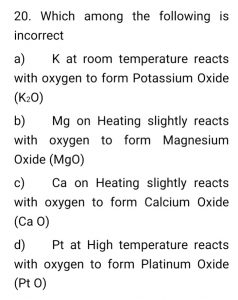 Correct
Correct
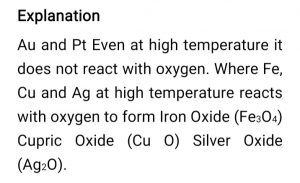 Incorrect
Incorrect

-
Question 21 of 56
21. Question
21. Which among the following is not the uses of Oxygen?
Correct
Explanation
Oxygen is used to remove carbon impurities from steel. It is used to oxidize rocket fuel. It is used for artificial respiration by scuba divers, mountaineers, astronauts, patients etc.
Incorrect
Explanation
Oxygen is used to remove carbon impurities from steel. It is used to oxidize rocket fuel. It is used for artificial respiration by scuba divers, mountaineers, astronauts, patients etc.
-
Question 22 of 56
22. Question
22. Which is an essential element present in proteins and nucleic acids which are the ‘building blocks’ of all living things?
Correct
Explanation
Nitrogen is one of the most important elements. Animals and plants need nitrogen for their growth. All living organisms (including us) contain nitrogen. It is an essential element present in proteins and nucleic acids which are the ‘building blocks’ of all living things.
Incorrect
Explanation
Nitrogen is one of the most important elements. Animals and plants need nitrogen for their growth. All living organisms (including us) contain nitrogen. It is an essential element present in proteins and nucleic acids which are the ‘building blocks’ of all living things.
-
Question 23 of 56
23. Question
23. Which Swedish scientist was the first to isolate nitrogen from the air in 1722?
Correct
Explanation
Nitrogen was first isolated from the air by Swedish chemist Carl Wilhelm Scheele in 1772. The name ‘nitrogen’ is derived from the Greek words ‘nitron’ and ‘gene’ meaning ‘I produce nitre’. Nitre is potassium nitrate compound of nitrogen.
Incorrect
Explanation
Nitrogen was first isolated from the air by Swedish chemist Carl Wilhelm Scheele in 1772. The name ‘nitrogen’ is derived from the Greek words ‘nitron’ and ‘gene’ meaning ‘I produce nitre’. Nitre is potassium nitrate compound of nitrogen.
-
Question 24 of 56
24. Question
24. Who suggested the name azote for Nitrogen, from the Greek word meaning ‘no life?
Correct
Explanation
Antoine Lavoisier suggested the name azote, from the Greek word meaning ‘no life’.
Incorrect
Explanation
Antoine Lavoisier suggested the name azote, from the Greek word meaning ‘no life’.
-
Question 25 of 56
25. Question
25. Which is the most abundant element on the earth by mass?
Correct
Explanation
Oxygen is the most abundant element on the earth by mass.
Incorrect
Explanation
Oxygen is the most abundant element on the earth by mass.
-
Question 26 of 56
26. Question
26. What is the position of nitrogen as the most abundant element in the human body by mass?
Correct
Explanation
Nitrogen is the fourth most abundant element in the human body by mass. It accounts for about three percent of the mass of the human body. It is thought to be the seventh most abundant element in the universe by mass.
Incorrect
Explanation
Nitrogen is the fourth most abundant element in the human body by mass. It accounts for about three percent of the mass of the human body. It is thought to be the seventh most abundant element in the universe by mass.
-
Question 27 of 56
27. Question
27. Which is the largest moon of Saturn, has an atmosphere made up of 98% Nitrogen?
Correct
Explanation
Titan, the largest moon of Saturn, has an atmosphere made up of 98% Nitrogen.
Incorrect
Explanation
Titan, the largest moon of Saturn, has an atmosphere made up of 98% Nitrogen.
-
Question 28 of 56
28. Question
28. Nitrogen exists in free state in the atmospheric air as _____
Correct
Explanation
Nitrogen occurs both in free state and combined state. Nitrogen exists in free state in the atmospheric air as dinitrogen (N2). It is present in volcanic gases and gases evolved by burning of coal.
Incorrect
Explanation
Nitrogen occurs both in free state and combined state. Nitrogen exists in free state in the atmospheric air as dinitrogen (N2). It is present in volcanic gases and gases evolved by burning of coal.
-
Question 29 of 56
29. Question
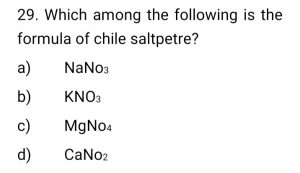 Correct
Correct
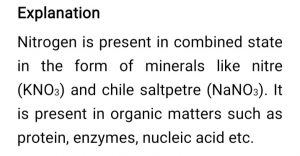 Incorrect
Incorrect

-
Question 30 of 56
30. Question
30. Which among the following is not the physical property of nitrogen?
Correct
Explanation
Nitrogen is slightly lighter than air. When it freezes, it becomes a white solid. It is neutral to litmus like oxygen.
Incorrect
Explanation
Nitrogen is slightly lighter than air. When it freezes, it becomes a white solid. It is neutral to litmus like oxygen.
-
Question 31 of 56
31. Question
31. Which among the following statement is incorrect
1) Nitrogen gets circulated in the air, soil and living things as the element itself or in the form of its compounds. Just as there is a circulation of carbon in nature so also there is a circulation of nitrogen. It is essential for the proper growth of all plants. The plants cannot make use of the elemental nitrogen from the air as such.
2) The plants require insoluble compounds of nitrogen. Thus, plants depend on other processes to supply them with nitrates. Any process that converts nitrogen in the air into a useful nitrogen compound is called nitrogen mixing. Mixing of nitrogen is carried out both naturally and by man.
Correct
Explanation
The plants require soluble compounds of nitrogen. Thus, plants depend on other processes to supply them with nitrates. Any process that converts nitrogen in the air into a useful nitrogen compound is called nitrogen fixation. Fixation of nitrogen is carried out both naturally and by man.
Incorrect
Explanation
The plants require soluble compounds of nitrogen. Thus, plants depend on other processes to supply them with nitrates. Any process that converts nitrogen in the air into a useful nitrogen compound is called nitrogen fixation. Fixation of nitrogen is carried out both naturally and by man.
-
Question 32 of 56
32. Question
32. Which among the following is incorrect about nitrogen?
Correct
Explanation
Liquid nitrogen is used as a refrigerant.
Incorrect
Explanation
Liquid nitrogen is used as a refrigerant.
-
Question 33 of 56
33. Question
33. Which among the following does not contains nitrogen?
Correct
Explanation
Many explosives such as TNT (Trinitrotoluene), nitro-glycerine, and gun powder contain nitrogen. It is used for the preservation of fresh foods, manufacturing of stainless steel, reducing fire hazards, and as part of the gas in incandescent light bulbs.
Incorrect
Explanation
Many explosives such as TNT (Trinitrotoluene), nitro-glycerine, and gun powder contain nitrogen. It is used for the preservation of fresh foods, manufacturing of stainless steel, reducing fire hazards, and as part of the gas in incandescent light bulbs.
-
Question 34 of 56
34. Question
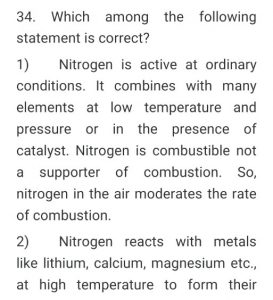
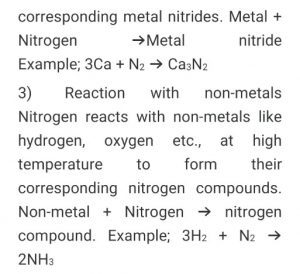 Correct
Correct
Explanation
Nitrogen is inactive at ordinary conditions. It combines with many elements at high temperature and pressure or in the presence of catalyst. Nitrogen is neither combustible nor a supporter of combustion. So, nitrogen in the air moderates the rate of combustion.
Incorrect
Explanation
Nitrogen is inactive at ordinary conditions. It combines with many elements at high temperature and pressure or in the presence of catalyst. Nitrogen is neither combustible nor a supporter of combustion. So, nitrogen in the air moderates the rate of combustion.
-
Question 35 of 56
35. Question
35. Which is evolved by the plants and animals during respiration and is produced during fermentation reactions?
Correct
Explanation
Carbon dioxide is present in air to the extent of about 0.03% in volume. It is evolved by the plants and animals during respiration and is produced during fermentation reactions.
Incorrect
Explanation
Carbon dioxide is present in air to the extent of about 0.03% in volume. It is evolved by the plants and animals during respiration and is produced during fermentation reactions.
-
Question 36 of 56
36. Question
36. Which among the following statement is correct
1) Carbon dioxide is a chemical compound in which one carbon and two oxygen atoms are bonded together. It is a gas at room temperature. It is represented by the formula CO2. It is found in the earth’s atmosphere and it sends back the solar energy which is reflected by the surface of the earth, to make it possible for living organisms to survive.
2) Human CO2 emissions upset the natural balance of the carbon cycle. Man-made CO2 in the atmosphere has increased global temperatures which is warming the planet. While CO2 derived from fossil-fuel is a very small component of the global carbon cycle, the extra CO2 is cumulative because the natural carbon exchange cannot absorb all the additional CO2.
3) Much of the naturally occurring CO2 is emitted from the marine vegetations. CO2 may also originate from the bio degradation of oil and gases. When carbon dioxide accumulates more in the atmosphere it produces great vegetation throughout earth and improves air circulation.
Correct
Explanation
Much of the naturally occurring CO2 is emitted from the magma through volcanoes. CO2 may also originate from the bio degradation of oil and gases. When carbon dioxide accumulates more in the atmosphere it produces harmful effects.
Incorrect
Explanation
Much of the naturally occurring CO2 is emitted from the magma through volcanoes. CO2 may also originate from the bio degradation of oil and gases. When carbon dioxide accumulates more in the atmosphere it produces harmful effects.
-
Question 37 of 56
37. Question
37. The process of conversion of solid into vapour without reaching liquid state is called ___
Correct
Explanation
The process of conversion of solid into vapour without reaching liquid state is called sublimation.
Incorrect
Explanation
The process of conversion of solid into vapour without reaching liquid state is called sublimation.
-
Question 38 of 56
38. Question
38. Which among the following is not the physical property of carbon dioxide?
Correct
Explanation
Carbon dioxide fairly soluble in water and turns blue litmus slightly red. So, it is acidic in nature. Carbon dioxide is non-combustible and not a supporter of combustion.Incorrect
Explanation
Carbon dioxide fairly soluble in water and turns blue litmus slightly red. So, it is acidic in nature. Carbon dioxide is non-combustible and not a supporter of combustion. -
Question 39 of 56
39. Question
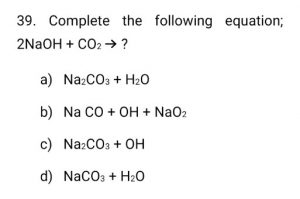 Correct
Correct
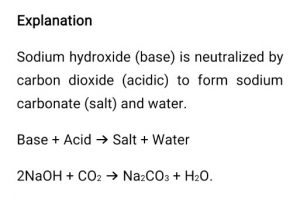 Incorrect
Incorrect

-
Question 40 of 56
40. Question
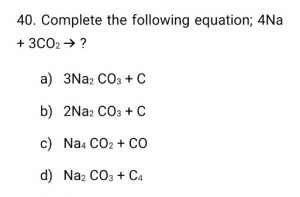 Correct
Correct
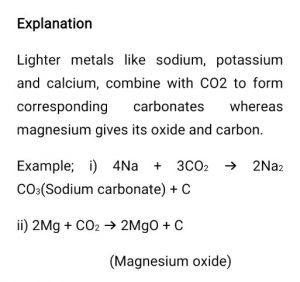 Incorrect
Incorrect

-
Question 41 of 56
41. Question
41. Which planet atmosphere consists of roughly 96-97% carbon dioxide?
Correct
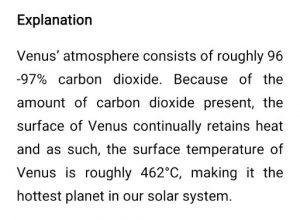 Incorrect
Incorrect

-
Question 42 of 56
42. Question
42. When a limited amount of CO2 is passed through lime water, it turns milky due to the formation of insoluble ____
Correct
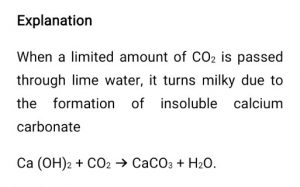 Incorrect
Incorrect

-
Question 43 of 56
43. Question
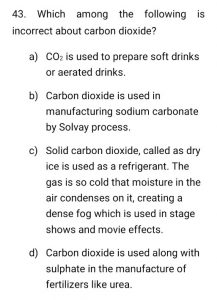 Correct
Correct
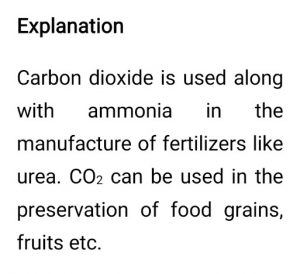 Incorrect
Incorrect

-
Question 44 of 56
44. Question
44. When an excess amount of CO2 is passed through lime water, it first turns milky and the milkiness disappears due to the formation of soluble ____
Correct
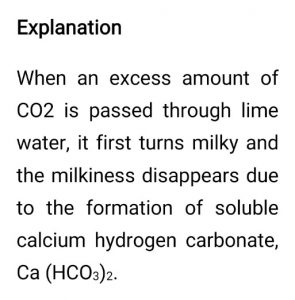 Incorrect
Incorrect

-
Question 45 of 56
45. Question
45. Aerated water is nothing but carbon dioxide dissolved in water under pressure also called as _________
Correct
Explanation
Aerated water is nothing but carbon dioxide dissolved in water under pressure. This is also called ‘soda water’.
Incorrect
Explanation
Aerated water is nothing but carbon dioxide dissolved in water under pressure. This is also called ‘soda water’.
-
Question 46 of 56
46. Question
46. The solar radiation is absorbed by the surface of land and ocean. In turn, they release infra-red radiation or heat into the atmosphere, some gases absorb this radiation and reradiate in all direction, these gases are called _____
Correct
Explanation
The solar radiation is absorbed by the surface of land and ocean. In turn, they release infra-red radiation or heat into the atmosphere. Certain gaseous molecules present in the atmosphere absorb the infra-red rays and reradiate the heat in all directions. Hence, these gases maintain the temperature of earth’s surface. The gases which absorb these radiations are called greenhouse gases and this effect is called greenhouse effect.
Incorrect
Explanation
The solar radiation is absorbed by the surface of land and ocean. In turn, they release infra-red radiation or heat into the atmosphere. Certain gaseous molecules present in the atmosphere absorb the infra-red rays and reradiate the heat in all directions. Hence, these gases maintain the temperature of earth’s surface. The gases which absorb these radiations are called greenhouse gases and this effect is called greenhouse effect.
-
Question 47 of 56
47. Question
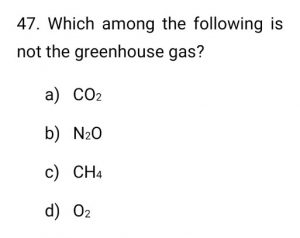 Correct
Correct
Explanation
The greenhouse gases are CO2, N2O, CH4, CFC (Chloro-Fluro carbon) etc. The increase in the levels of these gases results in the gradual increase of temperature of the earth’s surface.
Incorrect
Explanation
The greenhouse gases are CO2, N2O, CH4, CFC (Chloro-Fluro carbon) etc. The increase in the levels of these gases results in the gradual increase of temperature of the earth’s surface.
-
Question 48 of 56
48. Question
48. The increased greenhouse effect is caused due to increase in the air pollutants and it results in the average increase of temperature of the atmosphere. This is called as ____
Correct
Explanation
The increased greenhouse effect is caused due to increase in the air pollutants and it results in the average increase of temperature of the atmosphere. This is called as Global warming.
Incorrect
Explanation
The increased greenhouse effect is caused due to increase in the air pollutants and it results in the average increase of temperature of the atmosphere. This is called as Global warming.
-
Question 49 of 56
49. Question
49. Which among the following is incorrect regarding Global warming?
Correct
Explanation
Increase in frequency of floods, soil erosion and unseasonal rains.
Incorrect
Explanation
Increase in frequency of floods, soil erosion and unseasonal rains.
-
Question 50 of 56
50. Question
50. Which among the following is not the preventive measures of Global warming?
Correct
Explanation
In order to save the earth and its resources we need to take certain measures. Some of the measures are given below. 1. Reduction in the use of fossil fuels. 2. Controlling deforestation. 3. Restricting the use of CFCs. 4. Planting more trees. 5. Reducing, reusing and recycling resources.
Incorrect
Explanation
In order to save the earth and its resources we need to take certain measures. Some of the measures are given below. 1. Reduction in the use of fossil fuels. 2. Controlling deforestation. 3. Restricting the use of CFCs. 4. Planting more trees. 5. Reducing, reusing and recycling resources.
-
Question 51 of 56
51. Question
51. Pollutants such as oxides of nitrogen and sulphur in the air released by factories, burning fossil fuels, eruption of volcanoes etc., dissolve in rain water and form _____
Correct
Explanation
Rain water is actually the purest form of water. However, pollutants such as oxides of nitrogen and sulphur in the air released by factories, burning fossil fuels, eruption of volcanoes etc., dissolve in rain water and form nitric acid and sulphuric acid which adds up to the acidity of rain water. Hence, it results in acid rain.
Incorrect
Explanation
Rain water is actually the purest form of water. However, pollutants such as oxides of nitrogen and sulphur in the air released by factories, burning fossil fuels, eruption of volcanoes etc., dissolve in rain water and form nitric acid and sulphuric acid which adds up to the acidity of rain water. Hence, it results in acid rain.
-
Question 52 of 56
52. Question
52. Which among the following is incorrect about acid rain?
Correct
Explanation
Acid rain inhibits germination and growth of seedlings.
Incorrect
Explanation
Acid rain inhibits germination and growth of seedlings.
-
Question 53 of 56
53. Question
53. Acid rain has pH less than ____
Correct
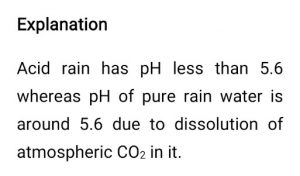 Incorrect
Incorrect

-
Question 54 of 56
54. Question
54. Which among the following is not the preventive measures of acid rain?
Correct
Explanation
Using non-conventional source of energy.
Incorrect
Explanation
Using non-conventional source of energy.
-
Question 55 of 56
55. Question
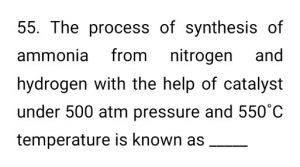 Correct
Correct
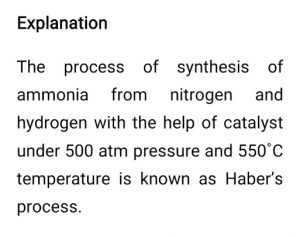 Incorrect
Incorrect

-
Question 56 of 56
56. Question
56. Which convert atmospheric nitrogen directly into soluble nitrogen compounds?
Correct
Explanation
Bacteria convert atmospheric nitrogen directly into soluble nitrogen compounds.
Incorrect
Explanation
Bacteria convert atmospheric nitrogen directly into soluble nitrogen compounds.
Leaderboard: Air Online Test 8th Science Lesson 11 Questions in English
| Pos. | Name | Entered on | Points | Result |
|---|---|---|---|---|
| Table is loading | ||||
| No data available | ||||